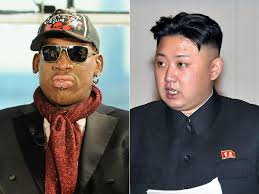“The plight of North Koreans barely registers on the world stage. The contrast with South Africa is telling. As the world mourns Nelson Mandela, how many people can name a single North Korean victim? David Feith
North Korea’s Dennis Rodman Problem
David Feith, The Wall StreetJournal, December 19, 2013, p. A 17
Now we know what it takes to turn world attention to the horrors of North Korea. Last week’s purge of Pyongyang’s second-in-command was a state  TV spectacle, with soldiers dragging Jang Song-thaek from an official meeting and later marching him into court, hunched over and handcuffed. Jang’s execution occurred off-screen—likely by firing squad—but the central news agency’s announcement was vivid in its own way, calling Jang “despicable human scum” who “was worse than a dog.”
TV spectacle, with soldiers dragging Jang Song-thaek from an official meeting and later marching him into court, hunched over and handcuffed. Jang’s execution occurred off-screen—likely by firing squad—but the central news agency’s announcement was vivid in its own way, calling Jang “despicable human scum” who “was worse than a dog.”
Couldn’t have happened to a nicer guy. Jang had been near the pinnacle of North Korean power since marrying into the ruling family in 1972. As brother-in-law to former leader Kim Jong Il and uncle to current leader Kim Jong Un, he helped keep his country’s 24 million people captive and miserable.
Thanks in part to Jang’s work, no North Korean can travel, speak or worship freely. As many as 2.5 million North Koreans died of starvation or related illness in the mid-1990s, according to Andrew Natsios, author of “The Great North Korean Famine.” That was one-tenth of the population. One million more have perished in political prisons, or kwalliso, where 200,000 still languish. Across this gulag, the dead lie unburied during frozen winters, prisoners dig their own graves before executions, and starving children scour for undigested kernels of corn in cow dung.
Yet North Korea’s cruelty rarely earns wide attention. Even the country’s nuclear arsenal is eclipsed in global consciousness—by ridicule.
Kim Jong Il was a tyrant who launched a thousand punch lines with his bouffant hairstyle, monochrome suits and platform shoes, along with his penchant for pornography and claim to five holes-in-one in a single golf round. An Economist magazine cover in 2000 showed him waving beneath the headline: “Greetings, earthlings.”
In 2004, a foul-mouthed, string-puppet version of Kim was the hilarious villain of “Team America: World Police,” a spoof from the creators of “South Park.” When the real Kim died in 2011, “Team America” was among Twitter‘s TWTR +5.19% most popular trending topics. “People responded to the death of one of the worst dictators of the 20th century with references to a cartoon puppet film,” Sokeel Park of the activist group Liberty in North Korea laments.
The trivialization of horror has accelerated in the Kim Jong Un era. Internet memes mock the young leader’s girth, haircut and Mao suits, while Elle magazine recently touted the trendiness of “North Korea chic,” distinguished by “sharp buckles and clasps and take-no-prisoners tailoring.”
Topping it off is the media frenzy around Dennis Rodman, the freakish former NBA star who celebrates Kim Jong Un as a “friend for life” and is now touring North Korea for the third time in a year. After his first pilgrimage, Mr. Rodman appeared on ABC’s “This Week” to convey Kim’s request that President Obama give him a call.
Amid all this, the plight of North Koreans barely registers on the world stage. The contrast with South Africa is telling. As the world mourns Nelson Mandela, how many people can name a single North Korean victim? Among the countless sites of North Korean brutality, there is no globally recognized Soweto. And it’s a rare diplomat or college student who could identify songbun, the decades-old system of political apartheid that dictates every North Korean’s life, from housing to education, jobs and food.
This is partly because North Korea is the Hermit Kingdom. The Kims have expended enormous energy cutting off their people from the outside world. Yet some first-hand accounts of life in North Korea exist and deserve wider attention.
The best-known may be journalist Blaine Harden’s “Escape From Camp 14,” about Shin Dong-hyuk, the only person known to have escaped North Korea (in 2005) after being born in a concentration camp. Kang Chol-hwan’s memoir “Aquariums of Pyongyang” recounts his imprisonment in the gulag as a teenager, from 1977-87. Mr. Kang’s experience is one of several dramatized in “Yodok Story,” a 2006 musical by fellow North Korean defector Jung Sung San.
Several movies—including ” Danny From North Korea,” “48m” and “Crossing,” called “a ‘ Schindler’s List’ for North Korea” by former Journal editor (and “Escape From North Korea” author) Melanie Kirkpatrick —depict what it means to defect. Most would-be defectors must cross the Tumen or Yalu rivers, where guards have shoot-to-kill orders, and enter China, where they must hide from police to avoid being repatriated to face imprisonment or execution in North Korea.
Most defectors hope to make it to Southeast Asia and ultimately to South Korea, but that requires luck and reliable help. Many women make it to China only to be sold into prostitution or forced marriages.
In this context it is perverse that the execution of the odious Uncle Jang should prompt so much overdue talk of the Kim regime’s cruelty. It’s also grim confirmation of a quip often attributed to Stalin : “One death is a tragedy. One million deaths is a statistic.”
Mr. Feith is an editorial writer at The Wall Street Journal Asia.
(function(i,s,o,g,r,a,m){i[‘GoogleAnalyticsObject’]=r;i[r]=i[r]||function(){
(i[r].q=i[r].q||[]).push(arguments)},i[r].l=1*new Date();a=s.createElement(o),
m=s.getElementsByTagName(o)[0];a.async=1;a.src=g;m.parentNode.insertBefore(a,m)
})(window,document,’script’,’//www.google-analytics.com/analytics.js’,’ga’);
ga(‘create’, ‘UA-46798390-1’, ‘wordpress.com’);
ga(‘send’, ‘pageview’);
